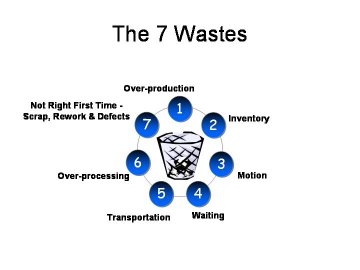
Toyota’s Taichi Ohno identified seven main sources of waste to be minimized in a Lean production system:-
Transportation
– the unnecessary movement of parts or materials. In our modern system of globalization where components are manufactured in many different parts of the world and transported to be assembled in a geographically remote location the opportunities for unnecessary transportation are endless. To minimize transportation waste we need to carefully analyze the origin of constituent parts and to identify opportunities for re-sourcing more local to final assembly.
Inventory – unnecessary inventory may as well be bags of cash. The operation needs to be streamlined to create a continuous flow minimizing inventory.
Motion – Any motion which is not adding value is Muda (waste) – for example if an operator has to repeatedly bend down to pick up a component this is unnecessary waste. The workstation should be designed to minimize unnecessary motion.
Waiting – time wasted whilst waiting for components, instructions, tools, indeed anything which is needed to maintain continuous flow is waste. If your organization is a service provider bear this in mind when designing systems to interface with customers. We all know the frustration of time wasted in a phone queue.
Overproduction – any production over and above the exact quantity the customer ordered is waste. The manufactured quantity should be pulled by the customer order.
Over-processing – the over embellishment or addition of none functional packaging is waste to be avoided and eliminated. What does the customer really want ?
Defects – all are waste and should be eliminated by the judicious use of 6 – sigma tools and Kaizen.
There are many other kinds of waste, which ones have you observed in your organization ?





